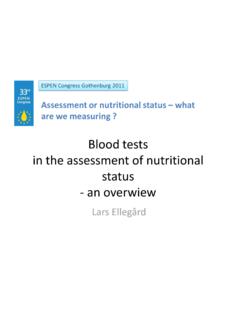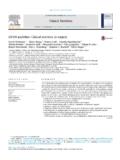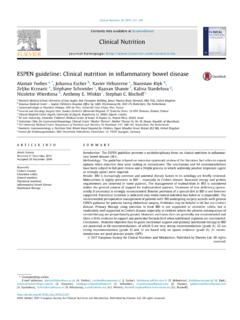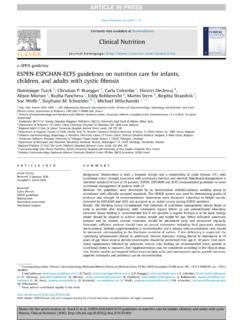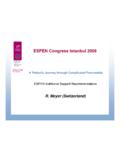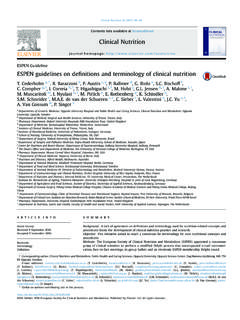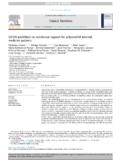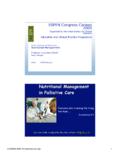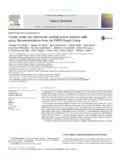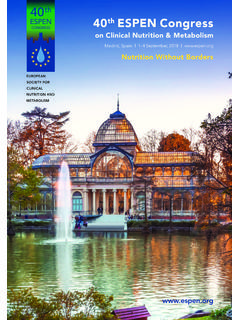Transcription of ESPEN guideline: Clinical nutrition in inflammatory bowel ...
1 ESPEN guideline: Clinical nutrition in inflammatory bowel diseaseAlastair Forbesa,*, Johanna Escherb, Xavier H ebuternec, Stanis aw K e kd,Zeljko Krznarice,St ephane Schneiderc, Raanan Shamirf, Kalina Stardelovag,Nicolette Wierdsmah, Anthony E. Wiskini, Stephan C. BischoffjaNorwich Medical School, University of East Anglia, Bob Champion Building, James Watson Road, Norwich, NR4 7UQ, United KingdombErasmus Medical CentereSophia Children's Hospital, Office Sp-3460, Wytemaweg 80, 3015 CN, Rotterdam, The NetherlandscGastroent erologie et nutrition Clinique, CHU de Nice, Universit eC^ote d'Azur, Nice, FrancedGeneral and Oncology Surgery Unit, Stanley Dudrick's Memorial Hospital, 15 Tyniecka Street, 32-050, Skawina, Krakau, PolandeClinical Hospital Centre Zagreb, University of Zagreb, Kispaticeva 12, 10000, Zagreb, CroatiafTel-Aviv University, Schneider Children's Medical Center of Israel, 14 Kaplan St.
2 , Petach-Tikva, 49202, IsraelgUniversity Clinic for Gastroenterohepatology, Clinical Centre Mother Therese , Mother Therese Str No 18, Skopje, Republic of MacedoniahVU University Medical Center, Department of nutrition and Dietetics, De Boelelaan 1117, 1081 HV, Amsterdam, The NetherlandsiPaediatric Gastroenterology& nutrition Unit, Bristol Royal Hospital for Children, Upper Maudlin Street, Bristol, BS2 8BJ, United KingdomjInstitut f r Ern ahrungsmedizin (180) Universit at Hohenheim, Fruwirthstr. 12, 70593 Stuttgart, Germanyarticle infoArticle history:Received 21 December 2016 Accepted 28 December 2016 Keywords:Crohn's diseaseUlcerative colitisEnteral nutritionParenteral nutritionInflammatory bowel diseaseNutritional therapysummaryIntroduction:The ESPEN guideline presents a multidisciplinary focus on Clinical nutrition in inflamma-tory bowel disease (IBD).
3 Methodology:The guideline is based on extensive systematic review of the literature, but relies on expertopinion when objective data were lacking or inconclusive. The conclusions and 64 recommendationshave been subject to full peer review and a Delphi process in which uniformly positive responses (agreeor strongly agree) were :IBD is increasingly common and potential dietary factors in its aetiology are briefly is highly prevalent in IBDeespecially in Crohn's disease. Increased energy and proteinrequirements are observed in some patients. The management of malnutrition in IBD is consideredwithin the general context of support for malnourished patients. Treatment of iron deficiency (paren-terally if necessary) is strongly recommended.
4 Routine provision of a special diet in IBD is not howeversupported. Parenteral nutrition is indicated only when enteral nutrition has failed or is impossible. Therecommended perioperative management of patients with IBD undergoing surgery accords with generalESPEN guidance for patients having abdominal surgery. Probiotics may be helpful in UC but not Crohn'sdisease. Primary therapy using nutrition to treat IBD is not supported in ulcerative colitis , but ismoderately well supported in Crohn's disease, especially in children where the adverse consequences ofsteroid therapy are proportionally greater. However, exclusion diets are generally not recommended andthere is little evidence to support any particular formula feed when nutritional regimens are :Available objective data to guide nutritional support and primary nutritional therapy in IBDare presented as 64 recommendations, of which 9 are very strong recommendations (grade A), 22 arestrong recommendations (grade B) and 12 are based only on sparse evidence (grade 0); 21 recom-mendations are good practice points (GPP).
5 2017 European Society for Clinical nutrition and Metabolism. Published by Elsevier Ltd. All rightsreserved.*Corresponding H K e Bischoff).Contents lists available atScienceDirectClinical Nutritionjournal homepage: 2017 European Society for Clinical nutrition and Metabolism. Published by Elsevier Ltd. All rights nutrition 36 (2017) 321e3471. IntroductionInflammatory bowel disease (IBD), predominantly ulcerativecolitis (UC) and Crohn's disease (CD), is now common in the entiredeveloped world. A systematic review conducted in 2012 demon-strated a range of prevalence rates for UC from to 505 per100,000, and for CD the estimates range from to 322 per100,000[1,2]. IBD affects children as well as adults, with 15e20% ofpatients being diagnosed during childhood[3].
6 A study fromScotland suggests that as much as 50% of IBD may now presentduring childhood and adolescence[4].The involvement of the gastrointestinal tract has encouragedthe investigation of the relationship between nutrition and IBD,both for ways to prevent IBD and to support IBD can occur as well in UC and CD, but is a considerablygreater problem in CD given its capacity to affect any part of thegastrointestinal tract, unlike UC, which is restricted to the colon andhas few direct malabsorptive effects[5]. As in adults, malnutritionis prevalent in paediatric IBD, mainly in active disease and more inCD than in both UC and CD malnutrition may be the result of reducedoral intake, increased nutrient requirements, increased gastroin-testinal losses of nutrients, and occasionally from drugenutrientinteractions[5].
7 The severity of malnutrition in IBD is influenced bythe activity, duration and extent of the disease, and particularly tothe magnitude of the inflammatory response which drives catab-olism and is anorexigenic. Patients with CD remain at risk evenwhen their disease appears quiescent, whereas patients with UCgenerally develop problems only when the disease is active[6].Although patients with IBD thus constitute a high-risk populationfor malnutrition, the principles of screening for malnutrition, withits subsequent assessment and management, are in common withthose for other chronic care is clearly important in the treatment of patientswith IBD and includes prevention of the treatment of malnutritionand micronutrient deficiencies, prevention of osteoporosis, and, inchildren promotion of optimal growth and development[7e11].
8 2. MethodologyThe present ESPEN guideline for Clinical nutrition in IBD beganwith updated methodology dating from 2011, which has since(2015) been replaced by new standard operating procedures forESPEN guidelines and consensus papers[12]. These new and morerigorous methodologies for ESPEN guidelines both have a focus ondisease rather than the historical technique-based approach(enteral vs parenteral). The multidisciplinary, multinationalapproach remains, but the guidelines are more structured anddepend on systematic review, relying on expert opinion only whenthe systematic approach is not possible or yields inconclusive re-sults. In the specific case of guidelines for Clinical nutrition in IBDthere were previous ESPEN guidelines for enteral and parenteralnutrition in gastrointestinal disease[13,14].
9 For the present guideline an expert writing panel was sought,both to retain some of the key contributors from 2006 and 2009 (bymutual consent) and to introduce new faces. An intended fullyintegrated approach for joint guidelines with the European Crohn'sand colitis Organisation (ECCO) and the European Society forPaediatric Gastroenterology Hepatology and nutrition (ESPGHAN)was explored, but although there were positive discussions prac-tical obstacles prevented this. The following guidelines are there-fore informed by discussion with representatives from ECCO andESPGHAN, but are not joint guidelines and form the recommen-dations of ESPEN alone. The expert panel was accredited by theESPEN Guidelines Group, by the ESPEN Education and ClinicalPractice Committee, and by the ESPEN Executive.
10 All members ofthe working group had declared their individual conflicts of inter-est according to the rules of the International Committee of MedicalJournal Editors (ICMJE).Following the previous methodology, the expert panel created aseries of Clinical questions for adult and paediatric practice, pre-sented according to the PICO formulation, which stands for Popu-lation, Intervention, Comparison and Outcome. PICO questionsaccordingly include short but exact definitions of the population ofinterest, the intervention, comparators, and outcome. It wasanticipated that the data would not permit satisfactory analyses inall cases and that for some questions data would be differentlyrobust for adult and child patients.
